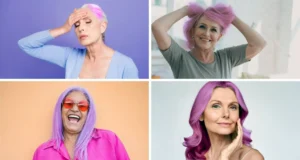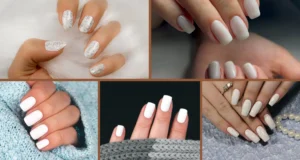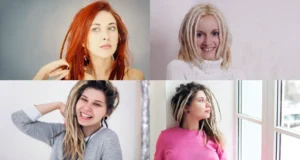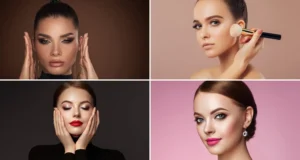Makeup has been both celebrated and criticized for centuries, but the reason girls paint their faces remains pretty simple – it makes them happy. Whether to hide insecurities, embrace confidence, express creativity, or fulfill cultural traditions, cosmetics provide an easy escape into a world where girls are judged not by the content of their character but by the color of their lipstick.
While natural beauty advocates argue girls should love themselves barefaced, makeup still brings millions of joy. Behind every well-blended eyeshadow lies a story of why a girl chose today to transform herself into the beautiful vision reflected back in the mirror, if only for a moment.
So, here is a comprehensive list of reasons why girls wear makeup. I hope this overview provides some helpful context around the various reasons girls choose to wear makeup!
Why Do Girls Wear Makeup
To boost confidence and self-esteem
Girls wear makeup for various reasons, mostly to boost their confidence and self-esteem. When girls put on makeup, they feel more beautiful and polished. Makeup gives them a feeling of completeness and readiness to face challenges for the day.
Putting on makeup becomes a self-care routine that makes girls feel good about themselves. When girls feel beautiful, it increases their sense of self-worth and confidence to interact with others and take on challenges at work or school.
The transformation that happens after applying makeup gives girls a moment of joy and happiness. It makes them feel more attractive and helps build their self-image as capable, attractive individuals.
In short, wearing makeup enables girls to project a powerful and confident personality to the outside world, helping them tackle everyday issues with more courage and optimism.
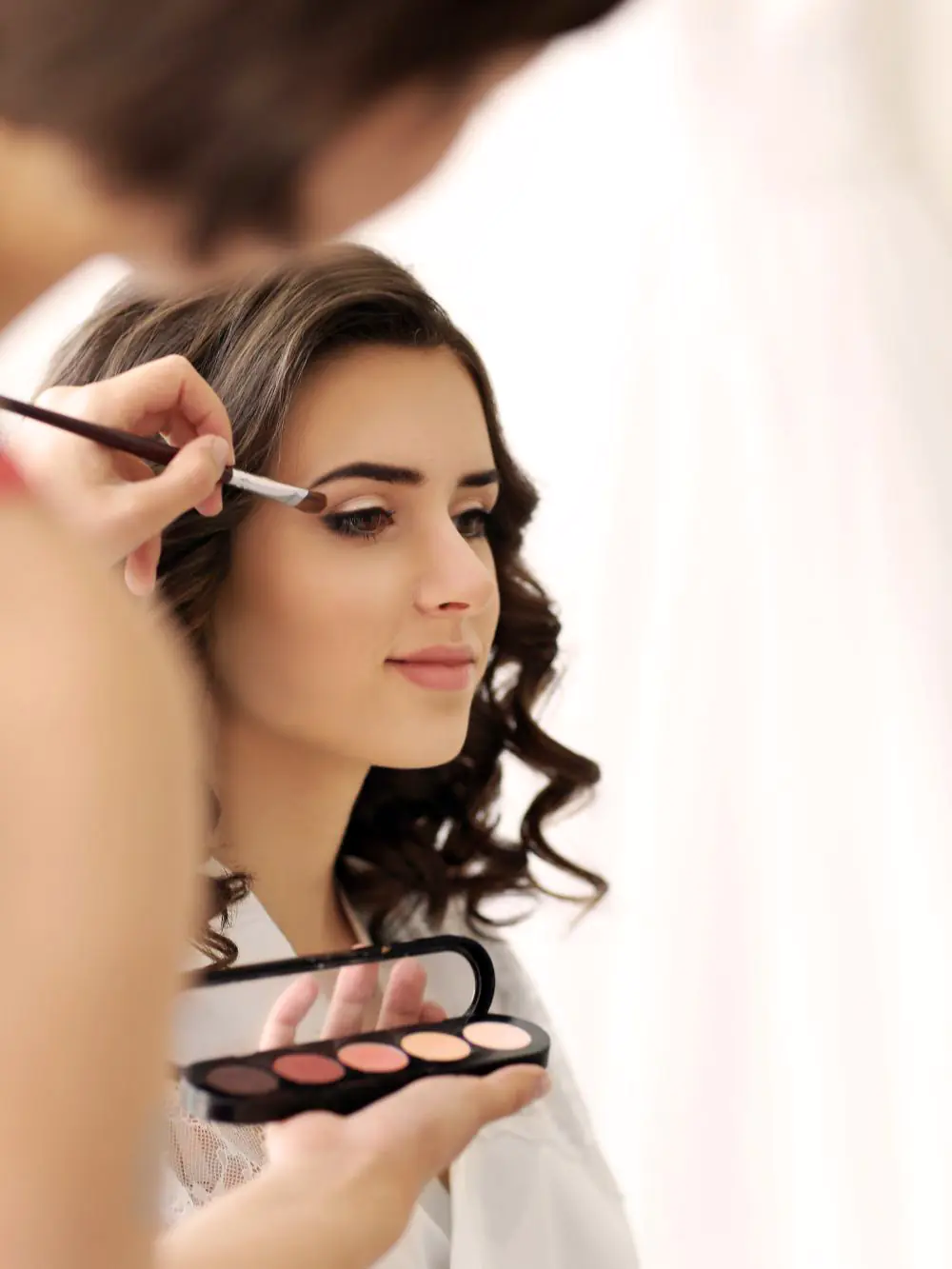
For self-expression and creativity
Girls wear makeup not only to look beautiful but also for self-expression and to enjoy their creative side. Applying makeup allows girls to experiment with different cosmetic products, colors, and techniques. It becomes an art form and creative outlet for them to try out new and innovative looks.
Girls can use makeup to translate their moods into different visually appealing styles. They can choose bright color palettes and styles to reflect that mood if they feel joyful. If they are experiencing a phase of darker emotions, they may prefer more muted tones in their makeup choices.
Putting on makeup in imaginative ways helps girls explore different aspects of their personalities. It channels their inner artist and allows them to think outside the box. Putting on makeup and seeing the end product in front of the mirror gives girls a feeling of satisfaction and achievement for having created something beautiful using their creative skills.
To enhance natural features
Girls wear makeup to enhance certain facial features and even out their complexion. Makeup allows girls to highlight their best assets, like their eyes, lips, or cheekbones. They can draw attention to these features with products like eyeliner, mascara, lipstick, and blush.
Makeup also helps cover up any perceived flaws or imperfections on their face. Girls apply foundation, concealer, and powder to even out their skin tone and hide blemishes, dark circles, and other skin issues. The goal is to achieve a balanced, harmonious look where all facial features come together proportionately.
Correct makeup helps accentuate what is already beautiful in a girl’s face. It brings out natural highlights and shapes of their features without looking overdone. This balanced, enhanced look using makeup gives girls a polished, well-groomed appearance that boosts their self-confidence.
But makeup is meant to complement a girl’s natural beauty, not to transform or hide it completely. Using judicious makeup helps girls appreciate and bring out the best in their facial features.
To cover up perceived flaws and skin issues
For some girls, wearing makeup covers up skin issues and hides perceived flaws on their faces. They apply makeup to disguise blemishes, acne breakouts, dark circles under the eyes, and other imperfections that they feel make them look less attractive.
Foundations, concealers, and color correctors help even out skin tone and cover up spots, dark marks, and fine lines. They give the face a smooth, flawless appearance. Some girls struggle with conditions like acne, melasma, or hyperpigmentation, which cause facial discoloration.
Wearing makeup helps them feel more confident by hiding these skin issues from public view. However, wearing makeup to cover perceived flaws is just a temporary solution.
Over time, excessive use of makeup to disguise flaws can worsen skin conditions and negatively impact self-esteem. Girls must realize that imperfections are natural and do not decrease their inherent worth or beauty. Learning to accept and love their natural skin will boost confidence in a longer-lasting way.
To follow current makeup trends
For many girls, wearing makeup is about following the current makeup trends and styles according to the fashion and beauty industries. They desire to look and dress like celebrities or social media influencers who set makeup trends. By copying these looks, girls hope to fit in with their peers and feel more accepted and popular.
Keeping up with the latest makeup trends gives a feeling of being modern, fashionable, and stylish. Girls see advertisements featuring models with trendy makeup styles that create the desire to replicate those looks. Makeup companies promote new products, colors, and techniques through social media. This heavy promotion influences girls to try the newest launches to stay “on trend”.
However, constantly attempting to follow fleeting makeup fads and fit an idealized stereotype ultimately leads to insecurity. Girls must realize that trends come and go, but natural beauty is forever. They should develop their unique style by experimenting with makeup that flatters and enhances their facial features rather than strictly copying trends.
To alter their appearance
For some girls, wearing makeup serves the purpose of changing or altering their natural appearance. They use different cosmetics to make themselves look older or younger than their actual age. Girls in their teens may apply makeup to appear more mature and worldly. They define their eyes with kohl, apply blush on cheeks, and wear lipstick to achieve a more grown-up look.
On the other hand, some girls use special foundations, concealers, and eye makeup to make themselves seem younger. Makeup tricks like highlighting and contouring help minimize the appearance of wrinkles and fine lines, giving a youthful glow.
Girls also experiment with different makeup styles to transform their overall facial appearance. They apply bold colors, special effects, or dramatic looks to make themselves look like a different person.
However, drastic changes to one’s natural appearance through makeup are only superficial and temporary. Regularly altering one’s looks can indicate a lack of self-acceptance and self-confidence. It is important for girls to love and embrace their natural selves.
As a form of “mask” or shield
For some girls, makeup has become more than just a fashion accessory or form of creativity and self-expression. They have come to rely on it as a “mask” or shield to cover up their insecurities and lack of confidence. These girls feel naked or exposed when they go out without any makeup on. Wearing makeup gives them a sense of security and comfort.
It helps hide perceived flaws and boosts their confidence to interact with others. But this behavior can become problematic over time if girls become overly dependent on makeup to feel good about themselves. Not wearing it may cause anxiety or negative thoughts about their appearance. This suggests a lack of self-acceptance and true confidence within.
To overcome this issue, girls must learn to love themselves as they are – makeup free. They need to build inner self-worth, not based on how they look on the outside. With time and effort, they can regain the confidence to go out without makeup, know that their worth does not depend on a cosmetic “mask,” and feel comfortable in their own skin.

To attract romantic interests
While attracting romantic interests is not the main reason most girls wear makeup, it can still play a role for some. Studies show that men find women who wear red lipstick and heavy eye makeup most attractive compared to those with little or no cosmetics.
So for some girls, wearing makeup is a way to enhance their chances of catching the eye of a potential partner. Lipstick, eye makeup, and blush give the face a well-groomed, “put-together” look that makes girls appear more feminine and desirable.
However, wearing makeup with the sole purpose of attracting others can be superficial and unhealthy. True intimacy is based on deeper connections, not just physical attraction. And people who value inner beauty over outward appearances make the most loving partners.
While a little makeup here and there is delicate, girls should focus more on developing inner confidence, strengths, and interests to have fulfilling relationships. Makeup is best used as an occasional enhancer, not a primary tactic to snag a date.
For special occasions
Many girls wear makeup more heavily and creatively for special occasions and events. Formals, proms, weddings, and parties allow them to experiment with dramatic and fun makeup looks that differ from their daily routine.
Girls choose bolder colors, heavier applications, and more defined features for these events. They wear false eyelashes, dark eye makeup, bright lip colors, and glittery and shimmering eye shadows.
This more dramatic application of makeup transforms their regular appearance into something glamorous and festive in keeping with the mood of the celebration. Wearing bold, standout makeup helps girls feel confident, excited, and ready to have a good time at these events.
However, taking the time and effort for an elaborate makeup look also becomes part of the experience and memory. Photos capturing the result remind girls of that special occasion years later.
So while daily makeup helps girls feel put together, makeup worn at parties and celebrations gives them a chance to highlight their creative and artistic side through beauty and cosmetics.
As a rite of passage
For some girls, starting to wear makeup signifies a rite of passage marking their transition into womanhood. As they reach adolescence and enter their teen years, makeup becomes a way for girls to explore and express their femininity.
They see older girls and women wearing it, so applying cosmetics themselves makes them feel more ‘grown up’. Wearing lipstick, blush, or eyeshadow helps girls feel part of the adult world. Using makeup gives a sense of ritual and habit that reflects a girl’s transformation from a child to a young lady.
However, womanhood is much more than just wearing cosmetics. Girls should be encouraged to develop other important traits like empathy, courage, independence, and strength of character. These inner qualities truly define one as a woman, far beyond external appearances.
While makeup, as a rite of passage, might boost a young girl’s confidence initially, focusing too much on it could generate insecurities later. Girls need to realize that makeup is optional and should only enhance, not replace, their natural beauty and poise that comes from within.
To gain confidence in the workplace or school
Many girls and women wear makeup when going to work or school to boost their confidence and competence. Wearing some makeup makes them feel put together, polished, and ready to take on the day’s challenges.
Even a small amount of makeup like lipstick, mascara, and foundation can make girls appear more groomed, authoritative, and prepared. This helps them feel more confident interacting with coworkers, classmates, and superiors. Makeup gives a sense of formality and seriousness, making girls feel they can command respect in professional or academic settings.
However, excessive or heavy makeup is not appropriate for work or school. Simple, natural-looking cosmetics in harmonizing shades best suit the office or classroom. The key is for girls to feel comfortable yet put together.
But ultimately, true confidence comes from within. When girls feel secure in their abilities, intelligence, and work ethic, makeup becomes an enhancer – not a requirement – to face each day with competence.
For religious or cultural reasons
In some cultures and religions, girls and women cover their faces with veils in public, often from a young age. Wearing a veil is considered modest and acceptable according to religious or cultural norms.
However, before covering the face, these girls often apply makeup to even out their complexion and enhance the parts of their face that will still be visible above or around the veil. They use foundation to provide an even skin tone and conceal skin imperfections. They also apply mascara, eyeliner, and eyeshadow to highlight their eyes.
Sometimes blush or lip color is added to draw attention to the mouth area. This targeted makeup aims to enhance the girls’ facial features that remain exposed despite the veil of cultural notions of beauty.
While veiling is seen as protecting modesty, strategic makeup within the bounds of the veil allows girls a sense of femininity and beautification. However, true beauty comes from inner strength and moral character rather than physical appearance alone.
To hide signs of aging
Many women use makeup as they age to hide signs of aging that can make them feel self-conscious. Makeup can temporarily disguise wrinkles, fine lines, age spots, and other aging indicators on the skin, making women feel more youthful and vibrant.
Products like special foundations, concealers, and color correctors help cover up signs of aging by giving the complexion a smoother, more even texture and tone. Creams and powders minimize the appearance of wrinkles, while fillers and highlighters are used to hide dark circles and shadows. Setting sprays set the makeup to last longer.
However, makeup is only a temporary fix. While it can boost confidence momentarily, women need to embrace the natural signs of aging. Focusing too much on disguising wrinkles and grey hair shows a lack of self-acceptance. True confidence and zest for life come from within rather than how young or old one appears on the outside.
For healing and therapeutic reasons
For some women, wearing makeup provides psychosocial benefits and acts as a coping mechanism, especially during or after undergoing medical procedures. Women who have experienced issues like cancer treatment, facial burns, or disfiguring accidents may use cosmetics to heal.
Makeup helps restore a sense of normalcy, femininity, and self-esteem that was lost due to their medical condition. It can improve mood, boost confidence and reduce anxiety.
Healthcare professionals recognize this therapeutic value of makeup and may involve a medical aesthetician in the recovery team. The aesthetician helps women apply cosmetics to minimize the appearance of scars, discoloration, or other side effects from their medical condition. This process allows women to regain a feeling of control over their appearance.
By enhancing certain features and de-emphasizing others, makeup camouflages the physical reminders of an illness or trauma. This new, improved appearance through makeup looks better and helps women feel emotionally and mentally better as they journey through recovery.
To distract from physical disabilities or differences
Some girls and women wear makeup to draw attention away from physical disabilities or differences that make them feel self-conscious in public. Makeup can help disguise birthmarks, scars, skin conditions, facial disfigurements, and other physical differences that the wearer is insecure about.
By applying cosmetics strategically, girls can draw the eye to certain desirable features while distracting from those they want to hide. Foundations, concealers, and color correctors work to cover up and even out the skin tone.
Eye makeup, blush, and lipstick are then applied to emphasize positive aspects of the face. This purposeful application of cosmetics allows girls to feel more comfortable in social settings by camouflaging their physical differences.
As a form of disguising one’s identity
For some people, wearing exaggerated or unusual makeup disguises their true identity and appearance. They apply heavy cosmetics as a form of camouflage for safety, privacy, or other reasons.
Those in the public eye, like celebrities, activists, and political figures, may wear outrageous makeup to avoid being recognized. This helps protect them from unwanted attention, stalking, and privacy intrusions. Individuals with abusive pasts may also use unusual makeup as a disguise to feel safe in public and avoid being tracked down.
Applying exaggerated cosmetics like thick foundation, unusual eye makeup, and extravagant lip colors can significantly alter a person’s appearance, making it hard to identify them.
However, disguising one’s identity through makeup is only a temporary measure. A healthier solution would be to address the root causes requiring such disguises. Individuals need to work towards gaining true safety and privacy through open communication, legal actions, and social reforms that minimize threats instead of constantly hiding behind exaggerated makeup.
For psychological benefits
Wearing makeup provides psychological benefits beyond just enhancing appearance. Applying makeup has been shown to improve cognitive functions like memory and focus for some girls and women.
The ritual of putting on makeup becomes a mindful routine that allows wearers to center themselves before taking on the day’s challenges. As they choose colors, apply products, and examine the results in the mirror, girls engage in a process that requires concentration, awareness, and patience. This mindfulness transfers to other tasks, boosting mental performance.
In addition, the confidence gained from feeling put together and attractive gives wearers a mood lift that reduces stress and anxiety. These positive feelings and alert mental state enable improved cognitive functioning.
However, makeup is not essential for psychological well-being. Building self-esteem from within and practicing other mindfulness techniques can provide cognitive benefits as effectively. Makeup should be an enhancer, not a requirement, for girls to feel focused, confident, and in control of their cognitive performance.
To fulfill a role or character
For actors, performers, and cosplayers, wearing makeup helps them inhabit their role, character, or persona. Taking on an alter ego through costumes and cosmetics allows them to step outside themselves and become the character they are playing.
Makeup helps create the visual transformation that completes the illusion. Actors apply cosmetics to look older or younger for certain roles—cosmetic techniques like contouring and highlighting facial change shapes. Wigs, hair dyes, false lashes, and prosthetics also affect the character’s appearance.
Together, all these elements help the actor or performer embody the character’s personality, mannerisms, and story. Cosplayers likewise use costume makeup to resemble characters from video games, anime, comics, and films as authentically as possible.
The meticulous makeup application becomes part of preparing for and fully slipping into the character or persona. Seeing the finished look in the mirror helps solidify the transformation, allowing actors, performers, and cosplayers to inhabit their new roles confidently.
For medical or health purposes
Some women wear makeup for medical or health-related purposes to cover skin conditions that otherwise make them feel self-conscious. Conditions like rashes, bruises, portwine stains, vitiligo, and others can cause discoloration, markings, or uneven skin texture that women want to hide.
Women can tactically cover affected areas by applying the right foundations, concealers, and color correctors to achieve an even, balanced complexion. This camouflaging of skin conditions through makeup helps boost confidence and reduce social anxiety. Women feel more comfortable going about daily activities without worrying about stares or unwanted attention.
However, makeup is only a temporary fix. Over time, excessive use of heavy-coverage products can further irritate skin conditions or cause new ones to develop. Women must work with dermatologists and healthcare providers to find long-term treatments for their specific conditions.
Meanwhile, accepting natural skin and conditions as part of their identity can generate true self-esteem regardless of appearance. Makeup should be an occasional enhancer, not a daily crutch.
To define a style
For some girls, wearing certain makeup styles helps define and express their unique personalities and fashion choices. Girls who identify with alternative styles like goth, punk, or indie tend to have specific makeup preferences that match the aesthetics of those subcultures.
Goth girls often wear dark eyeliner, pale foundation, and lipstick shades like black, deep red, or purple. Punk girls go for bold-colored hair, spiky eyeliner, and bright red lipstick. Indie girls favor a softer, natural look with dewy skin, neutral eyeshadows, and peachy lip gloss.
The right makeup influences the overall style and image that these girls wish to project. It becomes a crucial part of their self-expression. Choosing and applying makeup to match their identified subculture gives girls a sense of belonging and helps them find community among others who share their style.

To compensate for vision impairment.
Some women wear more dramatic makeup when they have low vision or are blind to compensate and make their facial features pop out more noticeably.
Since these women cannot see subtle or natural makeup applications, they tend to wear bolder cosmetics that will be clearly visible even with limited vision. They apply thicker foundations, heavier contouring, more defined eyebrows, and extra dark eyeliner to accentuate the shapes and features of their face.
Bold lip colors are also common to draw more attention to the mouth area. This stronger, heavier makeup application allows women with vision impairments to “feel seen” by others even if they cannot see how their makeup looks for themselves.
However, wearing excessive makeup should not become a source of anxiety. These women need to cultivate self-esteem based on more than just their appearance. True self-confidence comes from within, regardless of how others can see one’s outward makeup or physical attributes that often matter little in the greater scheme.
For spiritual or religious purposes
In some faiths and spiritual traditions, the act of applying makeup in certain designs and patterns holds religious significance. Makeup used for spiritual purposes often involves the application of henna or other natural pigments in intricate designs on the hands, feet, and body.
The patterns and markings symbolize spiritual concepts and hold meaning within the belief system. The ceremonial act of applying such designs becomes a meditative practice that helps devotees connect with their faith.
For example, in Hindu and Sikh traditions, applying henna before festivals and wedding ceremonies signifies spiritual values like devotion, purity, and joy. The colorful patterns adorning brides and celebrants symbolize their spiritual state during these important moments.
Makeup used in this context becomes more than just aesthetics – it represents an expression of faith and spirituality through the medium of the body. For believers, adorning the physical form with symbolic markings honors the divine spirit within and marks the wearer as a devotee of their path.
For cultural tradition
Traditional makeup practices have been passed down for generations as part of cultural customs and rites in some cultures. Certain looks using specific cosmetic techniques, tools, and even ingredients have evolved over time within these cultures.
Girls learn the traditional styles from a young age, typically from female elders. Customarily applying makeup becomes a means of expressing cultural identity, celebrating heritage, and connecting to the community. Traditional makeup practices mark important life moments like coming-of-age ceremonies, weddings, and festivals.
Girls’ style traditionally signifies their transition to womanhood within the cultural context. Photos capturing girls in their community’s signature makeup style help preserve these beautiful traditions for future generations.
While globalization and exposure to modern trends influence cultural makeup norms over time, preserving certain traditional practices – even in adapted forms – help cultures maintain a sense of distinct identity and continuity with the past. Makeup, in this context, becomes a cultural heritage to cherish.
As a professional requirement
For some professions, wearing makeup is an inherent job requirement rather than a personal choice. Actors, models, influencers, streamers, and others in the public eye often have to apply consistent cosmetics as part of their work. Their makeup becomes part of the image and brand they project to audiences.
For actors, appropriate makeup matches the needs of the character and script. Models must wear makeup that highlights their features to showcase different fashion looks. Influencers and streamers know their viewers expect a finished, well-groomed appearance in every video or post. Their expertise with makeup even becomes part of what they offer and promote.
Makeup artists may be employed to achieve the perfect cosmetic look. While natural makeup seems popular currently, heavier looks may be needed for specific photo shoots, environments, or high-definition cameras. Consistent makeup helps these professionals maintain a recognizable, brand-enhancing image.
For humor or fun
Some girls and women wear dramatic, unusual, or intentionally comedic makeup just for the purpose of humor and fun. They apply outrageous cosmetics for entertainment value rather than aesthetics.
Eyebrows drawn on in weird shapes, passionate lipstick colors, thick layers of foundation, and other exaggerated makeup amuse. Such makeup allows women to embrace their silly side and laugh at themselves. It gives them an excuse to set aside the fear of judgment for a moment and have fun experimenting with cosmetics in a lighthearted way.
Women who apply fun makeup intend to make viewers chuckle, smile or get a good laugh. Their over-the-top looks brighten people’s days and provide comic relief.
However, humor makeup should never cross the line into being hurtful or offensive. Respecting cultural sensitivities and one’s limitations prevents unintended consequences.
Ultimately, wearing dramatic makeup for laughs is a positive outlet for creativity when done with good intentions. Seeking to bring a bit of enjoyment and levity into the world through fun makeup shows a healthy sense of humor and lightens everyone’s spirit.
Out of habit or routine
For some women, applying makeup has become such an ingrained part of their daily routine that they continue the habit even on days when they have no plans to go out. Makeup application has become a force of habit, done automatically each morning without much thought. It has become part of their self-care and hygiene rituals alongside activities like showering, brushing their teeth, and hair styling.
Over the years, putting on makeup daily has shaped notions of looking presentable, professional, and “put together”. Not wearing any makeup may now feel odd, naked, or inappropriate instead of normal.
However, continuing makeup routines out of habit can be unhealthy if it creates anxiety or insecurity on makeup-free days. True confidence should not depend on cosmetics. Women need to reframe their thinking so that going without makeup sometimes feels relaxing and liberating instead of strange.
With a conscious effort, makeup application can transition from a force of habit to a choice based on preference for certain occasions. Rituals should bring joy, not unnecessary pressure.

Summary
Girls wear makeup for as many reasons as there are colors in their cosmetic cases. From the practical to the profound, makeup provides self-expression, social connection, escapism, and healing opportunities. Whether used sparingly or elaborately, cosmetics allow girls to alter their appearance to fulfill needs for confidence, creativity, enhancement, disguise, identity exploration, and womanhood.
Makeup gives girls a safe way to try on different personas and interpretations of beauty while learning life lessons about self-acceptance, health, and inner versus outer worth. Behind every brushstroke lies a unique story of why makeup, at that moment, brings joy and empowerment to a girl’s life. Yet beyond the surface gloss, true beauty always lies within.
FAQ
Was makeup made for boys or girls?
Makeup was not made for boys or girls specifically. The use of makeup dates back to ancient times, starting with the Egyptians around 6000 BCE. Both men and women of all social classes wore makeup, which was used to represent their wealth.
Is it OK for boys to wear makeup?
It is okay for boys to wear makeup. While makeup has traditionally been associated with women, there is no reason why boys cannot wear it if they choose to.
What age do girls start liking makeup?
According to clinical psychologist Dr. Jo-Ann Finkelstein, most kids typically start wearing makeup between 12-15 but may start experimenting earlier. A survey conducted by Superdrug in the UK found that the average age for girls to start wearing makeup was 11 years old. However, experts suggest that between the ages of 10 and 12 is an excellent time to introduce girls to the world of makeup by using a little bit of lip gloss.
Which country wears the least makeup?
Countries in Southern Europe, such as Spain, Greece, Portugal, and Scandinavia, have a culture where women wear less noticeable makeup during the day or at work. Dutch women also wear less makeup than in many other countries. Additionally, French women have been found to wear less makeup and prefer a more natural look.

